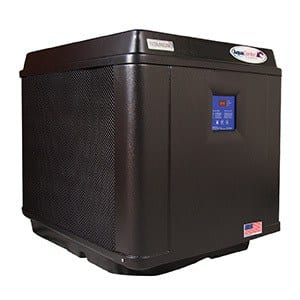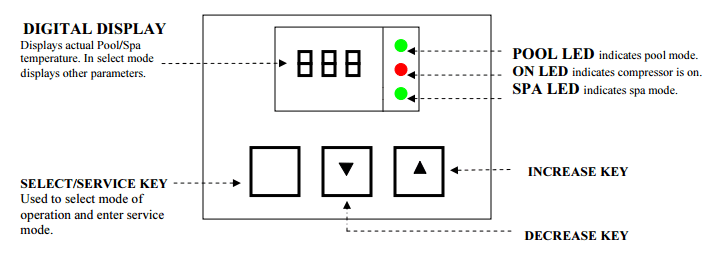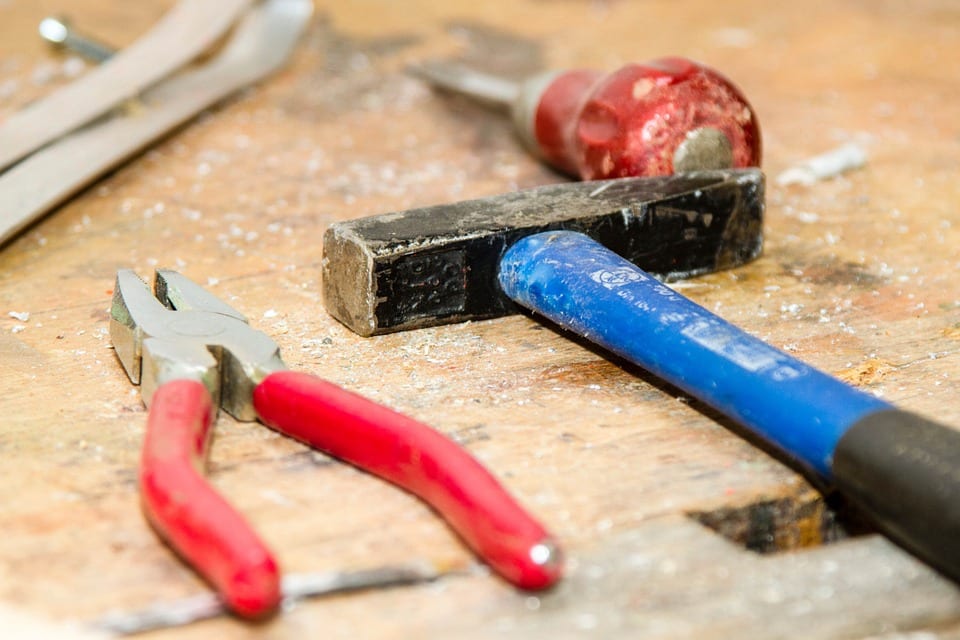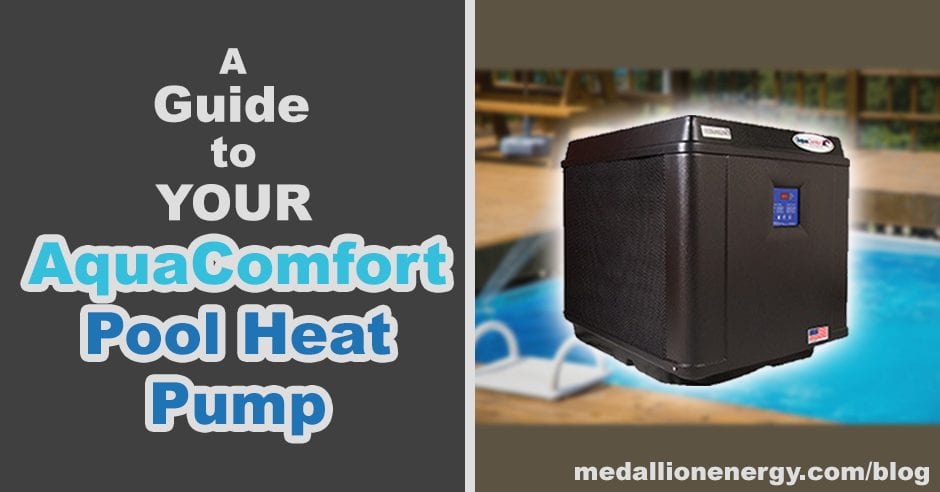If you want to learn more about your AquaComfort heat pump, but don’t have the time to get through the manual, keep reading
This post explains everything you need to know
Understanding a pool heat pump



An AquaComfort pool heater is, as you know, a pool heat pump. But what exactly does that mean? What makes a pool heat pump different from other pool heater types? Let’s answer those questions right now.
A pool heat pump is one of the most common pool heaters found across pools in America. Pool heat pumps rely on the natural heat in the air, so they’re ideal for a variety of conditions. They’re also energy efficient. In fact, pool heat pumps one of the most energy efficient pool heating options available, with an average coefficient of performance of 6.0. But what is it, exactly, that makes pool heat pumps so good at generating heat?
Let’s take a quick look at their design.
Learning about pool heat pump parts
Although pool heat pumps are made up of several parts, in this section, we’re focusing on those most essential to the heating process.
The most important part of a pool heat pump is easily the fan. By itself, the fan can’t do much. But with the help of a motor, it spins rapidly, pulling warm air through the unit and into the evaporator coil. This is where the heating process starts up — as warm air fuses with the eco-safe refrigerant inside of the coil, a warm gas is produced. This gas travels to the compressor, where it’s compressed into a hot gas. From here, the compressor pumps the hot gas into the heat exchanger. The heat exchanger allows water passing through to heat up as it flows over a hot inner tube (heated by the hot gas). Then, the heated water flows into your pool, and the heat pump repeats the cycle until the desired temperature is reached
[Want to know more about the process? Check out: How Air Source Pool Heat Pumps Work]
Using your AquaComfort Heat Pump



(These instructions are for the AquaComfort XL Series heat pump. Owners of other AquaComfort heat pumps can still follow these instructions, but unit buttons may differ slightly. For example, the “Select” button, which may be replaced by a “Pool/Spa Standby” button on certain models.)
How to turn on an Aquacomfort heat pump pool heater | Start Up
Once your pool heat pump has plumbing and electrical connections installed, the start up process goes as followed:
- Turn on your pool pump
- Apply power to your heat pump pool heater at the breaker
- Check heat pump display and verify that either “OFF”, or a temperature is showing
- Press the “Select” button until “OFF” is showing
- Press the “UP” arrow to switch to “ON”
How to select Pool or Spa mode
- Press the “Select” button until “P_S” displays
- Press the “UP” and “DOWN” arrows to switch between
“Pool” or “Spa” mode - An LED light will indicate which mode is selected
How to set temperature
- Press “Select” button until “Pool” or “Spa” displays
- Press the “UP” or “DOWN” arrow button to adjust temperature
- With your desired temperature selected, release the arrow key
- Wait 5 seconds (selected temperature will display)
- After 5 seconds, pool heat pump will revert to showing
current water temperature
How to select Cool or Heat (*Pool mode only)
- Press the “Select” button until “PHC” displays
- Press the “UP” and “DOWN” arrow buttons to
toggle between “P_H“, “P_C“, and “AUt” modes
(P_H = pool heat, P_C = pool cool, AUt = automatic)
Aquacomfort pool heater parts, and where to find them
If there’s one thing you should know about pool heater parts, it’s that quality matters — a lot. So don’t give in to the temptation of the slightly cheaper, mass produced, generic pool heater parts. If the parts aren’t designed specifically for your AquaComfort pool heater, don’t take the chance. Using the wrong parts can cause damage to your heat pump (as we explain in this post).
Instead, avoid the risk altogether, and choose OEM pool heater parts. These are manufacturer parts identical to those inside of your pool heater.
Where to find genuine AquaComfort pool heater parts (OEM pool heater parts)
Whether it’s a heat pump temperature sensor or new fan motor, you can find everything you need right here: AquaComfort pool heater parts
5 Common AquaComfort Heat Pump Problems
There’s a puddle of water around my AquaComfort heat pump, is it leaking from the inside?
Probably not. Pool heat pumps can produce a lot of condensation (up to 3 gallons per hour), especially when it’s hot outside. A small puddle around the heat pump is generally normal, and a result of it “sweating.” But just to be safe, use a test strip to test the water — if its condensation, there won’t be any chlorine.
Frost sometimes forms on the evaporator coil during colder weather. Is this bad?
When outside temperatures are on the chilly side, the condensation on a pool heat pump’s evaporator coil can freeze. The frost/ice is normal and melts away naturally with the pool heat pump’s defrost cycle. (The process is not instant, and may take a bit of time)
My pool heater isn’t heating as fast when it’s cold outside, is this okay?
Perfectly okay, and normal.
A pool heat pump’s effectiveness is controlled by the availability of heat (as explained earlier). Since they harvest natural heat straight from the air, the outside temperature is a significant factor. Therefore, the hotter the weather, the faster a pool heat pump heats, and vice versa.
Why do I keep seeing the “FLO” error code?
You’ll usually see this code when your pump is turned off or on. The code is no reason for worry and simply means that the pool heat pump detects a change in water flow. If left alone, the heater automatically shuts off since it can’t function without a constant stream of water.
I lost my pool heat pump owner’s manual, what do I do?
Don’t worry. We have them all right here. Just click the link for your Aquacomfort heat pump:
AquaComfort Vintage Classic Owner’s Manual
AquaComfort Signature Series Owner’s Manual
AquaComfort Classic Black Owner’s Manual
AquaComfort XL Series Owner’s Manual
AquaComfort Heat Pump Troubleshooting



Below are some of the most common issues you’ll face when using your pool heater, accompanied by a few tips for troubleshooting them. Of course, this doesn’t cover everything. If you still can’t figure out what’s wrong, consider a pool heater troubleshooting service.
Low water flow
Possible causes:
- Dirty/clogged filter
- Clogged skimmer or pump basket
- Pool water level too low
- Broken or faulty pressure sensor
Pool heater is not heating
Possible causes:
- Broken or faulty temperature sensor
- Incorrect automatic timer settings
- Incorrect pool heat pump size
(Need help with sizing? Size a pool heat pump)
Pool heater keeps turning off and on
Possible causes:
- Weak or insufficient electrical connection
- Low water flow
- Dirty or corroded heat exchanger
Not sure what’s wrong with your pool heat pump? Know what’s wrong but aren’t sure how to fix it? Check out our LIVE Pool Heater Troubleshooting
How/where can I repair my AquaComfort heat pump pool heater?
Of course, you might not have the time to go through all of the troubleshooting steps. Maybe you just want your pool heat pump working as soon as possible. Especially if it’s near summertime when you’re reading this, because who could blame you?
Regardless of your reasons, you need reliable pool heat pump repair. Repair handled by experienced and skilled professionals who get the job done right the first time. You need pool heat pump specialists. Well, you stumbled across the right blog.
[Need to repair your pool heater? We offer affordable, professional pool heat pump repair]
Closing thoughts
We hope this condensed guide for AquaComfort heat pumps helps you get better acquainted with your pool heater. Whether you’re turning it on for the first time, or troubleshooting, having a solid understanding of your heat pump is essential. Knowing how parts work, and what role each play can save loads of times and plenty of headaches. But the best piece of advice we can give is, always, to regularly maintain and service your pool heat pump. Treat it good, and it’ll keep going strong for years to come.


